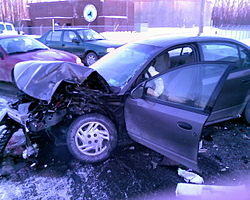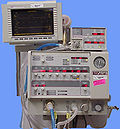Pulmonary contusion
A pulmonary contusion (or lung contusion) is a contusion (bruise) of the lung, caused by chest trauma. The bruise harms the capillaries, and then blood and other liquids collect in the lungs. These extra liquids prevent with gas exchange. Without gas exchange, oxygen levels drop (hypoxia). If the lung is cut, then the injury is instead a pulmonary laceration and has different symptoms.
A lung contusion is usually caused by blunt trauma. Explosion injuries or a shock wave from a penetrating trauma may also cause this injury.
Doctors began studying this injury after explosives hurt soldiers in World Wars I and II. In the 1960s when cars became popular people began to get this kind of injury from car accidents.
Classification

Lung contusion and laceration are injuries to the lung. In contusion, the structure of the lung does not change. In laceration, the pieces of lung may be moved.[1][2] When blood fills lacerations, the injury is called pulmonary hematoma.[3] The difference between a contusion and a hematoma is that in a contusion, the alveoli (tiny air-filled sacs that give oxygen) will bleed, but a hematoma is a blood clot.[4]
If the pleural cavity (the space outside the lung) accumulates blood (hemothorax) or air (pneumothorax) or both (hemopneumothorax) then this is called a collapsed lung. These conditions do not always damage the lung but they might, or they might be the result of damage. Injuries to the chest wall are also distinct from but may happen with lung injuries. Chest wall injuries include rib fractures and flail chest. In flail chest multiple ribs are broken move independently of the rib cage.
Causes
Pulmonary contusion is the most common injury found in blunt chest trauma,[5] occurring in 25–35% of cases.[6] It is usually caused by a collision while moving quickly.[7] About 70% of cases result from motor vehicle collisions,[8] most often when the chest strikes the inside of the car.[9] Falls,[8] assaults,[10] and sports injuries are other causes.[11] Pulmonary contusion can also be caused by explosions. The organs most harmed by blast injuries are those that hold gas, such as the lungs.[12] Blast lung is severe pulmonary contusion, bleeding, or edema with damage to alveoli and blood vessels, or a combination of these.[13] This is the usual cause of death among people who initially survive an explosion.[14] Unlike other causes of injury in which pulmonary contusion is often found with other injuries, explosions can cause pulmonary contusion without damage to the chest wall.[5]
Pulmonary Contusion Media
The alveoli
Motor vehicle collisions are the most common cause of pulmonary contusion.
Normally, oxygen and carbon dioxide diffuse across the capillary and alveolar membranes and the interstitial space (top). Fluid impairs this diffusion, resulting in less oxygenated blood (bottom).
A chest X-ray showing right sided (seen on the left of the picture) pulmonary contusion associated with rib fractures and subcutaneous emphysema
A chest CT scan revealing pulmonary contusions, pneumothorax, and pseudocysts
An ultrasound image showing early pulmonary contusion, at this moment not visible on radiography. Lung swelling is seen as vertical white lines, the "B-lines".
Mechanical ventilation may be required if pulmonary contusion causes inadequate oxygenation.
A chest X-ray showing acute respiratory distress syndrome
References
- ↑ Collins J, Stern EJ (2007). Chest Radiology: The Essentials. Lippincott Williams & Wilkins. p. 120. ISBN 978-0-7817-6314-1.
- ↑ Wicky S, Wintermark M, Schnyder P, Capasso P, Denys A (2000). "Imaging of blunt chest trauma". European Radiology. 10 (10): 1524–1538. doi:10.1007/s003300000435. PMID 11044920. S2CID 22311233.
{{cite journal}}: CS1 maint: multiple names: authors list (link) - ↑ Stern EJ, White C (1999). Chest Radiology Companion. Hagerstown, MD: Lippincott Williams & Wilkins. pp. 103. ISBN 0-397-51732-7.
- ↑ Livingston DH, Hauser CJ (2003). "Trauma to the chest wall and lung". In Moore EE, Feliciano DV, Mattox KL (ed.). Trauma. Fifth Edition. McGraw-Hill Professional. pp. 525–528. ISBN 0-07-137069-2.
{{cite book}}: CS1 maint: multiple names: editors list (link) - ↑ 5.0 5.1 Simon, Bruce; Ebert, James; Bokhari, Faran; Capella, Jeannette; Emhoff, Timothy; Hayward, Thomas; Rodriguez, Aurelio; Smith, Lou; Eastern Association for the Surgery of Trauma (2012). "Management of pulmonary contusion and flail chest". Journal of Trauma and Acute Care Surgery. 73 (5): S351–S361. doi:10.1097/TA.0b013e31827019fd. PMID 23114493. S2CID 34574806.
- ↑ Moloney JT, Fowler SJ, Chang W (February 2008). "Anesthetic management of thoracic trauma". Current Opinion in Anesthesiology. 21 (1): 41–46. doi:10.1097/ACO.0b013e3282f2aadc. PMID 18195608. S2CID 39075971.
{{cite journal}}: CS1 maint: multiple names: authors list (link) - ↑ Yamamoto L, Schroeder C, Morley D, Beliveau C (2005). "Thoracic trauma: The deadly dozen". Critical Care Nursing Quarterly. 28 (1): 22–40. doi:10.1097/00002727-200501000-00004. PMID 15732422.
{{cite journal}}: CS1 maint: multiple names: authors list (link) - ↑ 8.0 8.1 Ullman EA, Donley LP, Brady WJ (2003). "Pulmonary trauma emergency department evaluation and management". Emergency Medicine Clinics of North America. 21 (2): 291–313. doi:10.1016/S0733-8627(03)00016-6. PMID 12793615.
{{cite journal}}: CS1 maint: multiple names: authors list (link) - ↑ Miller DL, Mansour KA (2007). "Blunt traumatic lung injuries". Thoracic Surgery Clinics. 17 (1): 57–61. doi:10.1016/j.thorsurg.2007.03.017. PMID 17650697.
- ↑ Haley K, Schenkel K (2003). "Thoracic trauma". In Thomas DO, Bernardo LM, Herman B (ed.). Core curriculum for pediatric emergency nursing. Sudbury, Mass: Jones and Bartlett Publishers. pp. 446. ISBN 0-7637-0176-9.
{{cite book}}: CS1 maint: multiple names: editors list (link) - ↑ France R (2003). "The chest and abdomen". Introduction to Sports Medicine and Athletic Training. Thomson Delmar Learning. pp. 506–507. ISBN 1-4018-1199-X.
- ↑ Cohn SM (1997). "Pulmonary contusion: Review of the clinical entity". Journal of Trauma. 42 (5): 973–979. doi:10.1097/00005373-199705000-00033. PMID 9191684.
- ↑ Sasser SM, Sattin RW, Hunt RC, Krohmer J (2006). "Blast lung injury". Prehospital Emergency Care. 10 (2): 165–72. doi:10.1080/10903120500540912. PMID 16531371. S2CID 2912045.
{{cite journal}}: CS1 maint: multiple names: authors list (link) - ↑ Born CT (2005). "Blast trauma: The fourth weapon of mass destruction" (PDF). Scandinavian Journal of Surgery. 94 (4): 279–285. doi:10.1177/145749690509400406. PMID 16425623. S2CID 44680290. Archived from the original (PDF) on 2009-02-25. Retrieved 2015-08-10.









